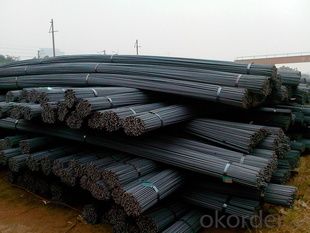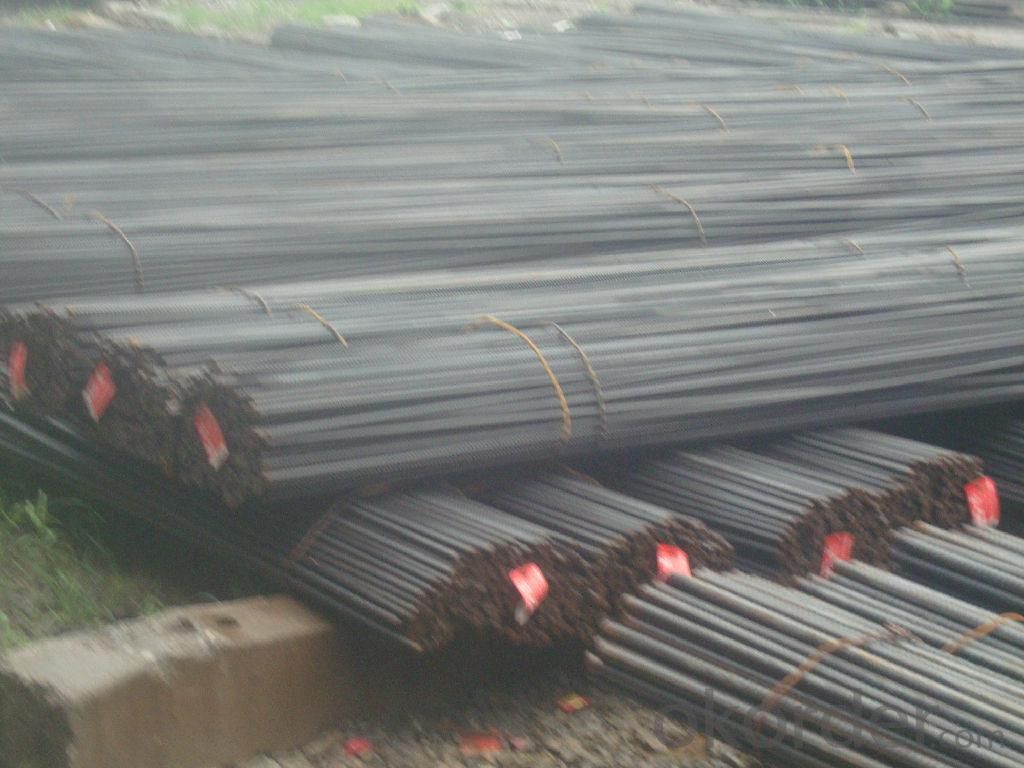S65C deformed steel bars for construction standard
- Loading Port:
- Tianjin
- Payment Terms:
- TT or LC
- Min Order Qty:
- 25 m.t.
- Supply Capability:
- 100000 m.t./month
OKorder Service Pledge
OKorder Financial Service
You Might Also Like
Product Description:
OKorder is offering S65C deformed steel bars for construction standard at great prices with worldwide shipping. Our supplier is a world-class manufacturer of steel, with our products utilized the world over. OKorder annually supplies products to European, North American and Asian markets. We provide quotations within 24 hours of receiving an inquiry and guarantee competitive prices.
Product Applications:
S65C deformed steel bars are ideal for structural applications and are widely used in the construction of buildings and bridges, and the manufacturing, petrochemical, and transportation industries.
Product Advantages:
OKorder's deformed steel bars are durable, strong, and resist corrosion.
Main Product Features:
· Premium quality
· Prompt delivery & seaworthy packing (30 days after receiving deposit)
· Corrosion resistance
· Can be recycled and reused
· Mill test certification
· Professional Service
· Competitive pricing
Product Specifications:
Specifications
1.commodity:deformed steel bars
2.grade:ASTM A615 HRB335 HRB400 HRB500 BS4449 grade460
3.size:6#-32#
4.length:6m 9m 12m
We henglong can offer high quality deformed steel bar
grade:ASTM A615 BS4449 GRADE460 HRB335 HRB400 HRB500
size:6# to 32#
length:6M 9M 12M
Chemistry % | |||||||||||||
Designation | Chief component | Impurities maxmium | |||||||||||
Ta | Nb | Fe | Si | Ni | W | Mo | Ti | Nb | O | C | H | N | |
Ta1 | Remainder | 0.004 | 0.003 | 0.002 | 0.004 | 0.004 | 0.002 | 0.03 | 0.015 | 0.004 | 0.0015 | 0.002 | |
Ta2 | Remainder | 0.01 | 0.01 | 0.005 | 0.02 | 0.02 | 0.005 | 0.08 | 0.02 | 0.01 | 0.0015 | 0.01 | |
Permissible variations in diameter for rods
Diameter, inch (mm) | Tolerance, +/-inch (mm) |
0.125~0.187 excl (3.175~4.750) | 0.003 (0.076) |
0.187~0.375 excl (4.750~9.525) | 0.004 (0.102) |
0.375~0.500 excl (9.525~12.70) | 0.005 (0.127) |
0.500~0.625 excl (12.70~15.88) | 0.007 (0.178) |
0.625~0.750 excl (15.88~19.05) | 0.008 (0.203) |
0.750~1.000 excl (19.05~25.40) | 0.010 (0.254) |
1.000~1.500 excl (25.40~38.10) | 0.015 (0.381) |
1.500~2.000 excl (38.10~50.80) | 0.020 (0.508) |
2.000~2.500 excl (50.80~63.50) | 0.030 (0.762) |
For more details please go to our website, and welcome to China to visit our company.
Special requirements to be agreed on by the supplier and buyer of negotiation.
Note:
1. Our products are produced according to national standard (GB), if not, supply according to national standards (GB) or agreement as customer required.
2. Other Grade and Standard Deformed Steel Bar we can supply:
Grade: GR40/GR60, G460B/B500A/B500B/B500C,BST500S
Standard: ASTM, BS, DIN
The Minimum Order Quantity of these products is high, and need to be confirmed.
3. We can not only supply Deformed Steel Bar; if you need anything about building materials, please contact us for further information.
4. Please send us your detail specifications when inquire. We will reply to you as soon as possible. We sincerely hope we can establish a long stable business relationship.



FAQ:
Q1: What makes stainless steel stainless?
A1: Stainless steel must contain at least 10.5 % chromium. It is this element that reacts with the oxygen in the air to form a complex chrome-oxide surface layer that is invisible but strong enough to prevent further oxygen from "staining" (rusting) the surface. Higher levels of chromium and the addition of other alloying elements such as nickel and molybdenum enhance this surface layer and improve the corrosion resistance of the stainless material.
Q2: Can stainless steel rust?
A2: Stainless does not "rust" as you think of regular steel rusting with a red oxide on the surface that flakes off. If you see red rust it is probably due to some iron particles that have contaminated the surface of the stainless steel and it is these iron particles that are rusting. Look at the source of the rusting and see if you can remove it from the surface.
- Q:How do steel rebars affect the overall construction schedule?
- Steel rebars can have both positive and negative impacts on the overall construction schedule. On the positive side, rebars, being strong and durable, can enhance the structural integrity of the building, making it safer and more resilient. They also help in speeding up the construction process by providing strength and support to the concrete, allowing for faster curing times. However, the availability and delivery of rebars can sometimes cause delays if there are supply chain issues or if the required quantity is not readily available. Additionally, the installation of rebars requires precision and coordination with other construction activities, which can also impact the timeline. Therefore, while steel rebars can contribute to a more efficient construction schedule, they can also pose challenges and potential delays if not managed properly.
- Q:Can steel rebars be used in earthquake-resistant buildings?
- Yes, steel rebars can be used in earthquake-resistant buildings. Steel rebars are commonly used in construction to reinforce concrete structures, providing strength and durability. In earthquake-resistant buildings, steel rebars are strategically placed to distribute and absorb the seismic forces generated during an earthquake, preventing structural failure and reducing the risk of collapse. This reinforcement helps to enhance the overall stability and resilience of the building, making it more resistant to seismic activity.
- Q:Can steel rebars be used in tunnel lining construction?
- Yes, steel rebars can be used in tunnel lining construction. Rebars provide reinforcement and strength to the concrete used in tunnel lining, making it more durable and resistant to structural stresses.
- Q:What is the average lifespan of steel rebars in marine environments?
- The average lifespan of steel rebars in marine environments varies depending on several factors such as the quality of the steel, level of exposure to saltwater and other corrosive elements, maintenance practices, and design considerations. However, with proper corrosion protection measures and regular maintenance, steel rebars in marine environments can typically last around 30 to 50 years.
- Q:What is the diameter range of steel rebars?
- The diameter range of steel rebars typically varies from 6mm to 50mm.
- Q:Can steel rebars be used in sustainable construction practices?
- Yes, steel rebars can be used in sustainable construction practices. They are commonly used in reinforced concrete structures, which have a long lifespan and can be recycled at the end of their life. Additionally, steel rebars can contribute to the overall strength and durability of a building, reducing maintenance and replacement needs. Furthermore, using steel rebars can enhance the energy efficiency of a structure by providing thermal mass, which helps in reducing heating and cooling requirements.
- Q:Do steel rebars increase the overall weight of a structure?
- Yes, steel rebars do increase the overall weight of a structure. Rebars are typically used to reinforce concrete, providing additional strength and stability. Since steel is denser than concrete, the addition of rebars adds weight to the structure.
- Q:Are steel rebars suitable for use in high-temperature applications?
- High-temperature applications are generally not suitable for the use of steel rebars. Despite being a strong and durable material, steel has limitations when exposed to high temperatures. It can undergo a significant reduction in strength and even a loss of structural integrity, leading to potential failures. When subjected to high temperatures, steel goes through a process known as thermal expansion, which can weaken and deform it. This phenomenon is particularly noticeable in rebars, which are commonly used to reinforce concrete structures. The high temperatures cause the rebars to expand, exerting excessive pressure on the surrounding concrete. This pressure can result in cracks and potentially compromise the stability of the structure. Furthermore, prolonged exposure to high temperatures can cause a loss of the steel's mechanical properties, including its tensile strength and load-bearing capacity. As a result, the rebars become less effective in resisting external forces and reinforcing the concrete. For this reason, it is generally recommended to consider alternative materials, such as stainless steel or special alloys, for high-temperature applications. These materials are specifically designed to withstand elevated temperatures without compromising their structural integrity. To ensure safety and structural stability, it is important to consult with experts and engineers who are familiar with high-temperature applications in order to determine the most suitable materials for specific projects.
- Q:Are steel rebars suitable for reinforcement in airport runways?
- Yes, steel rebars are suitable for reinforcement in airport runways. They provide excellent strength, durability, and resistance to heavy loads and impacts, making them an ideal choice for ensuring the structural integrity and safety of airport runways.
- Q:How are steel rebars affected by temperature fluctuations?
- Steel rebars are affected by temperature fluctuations in several ways. Firstly, when exposed to high temperatures, steel rebars can expand, which can lead to cracking and weakening of the structure they are supporting. On the other hand, in extremely cold temperatures, steel rebars can contract, potentially causing stress and cracking. These temperature fluctuations can also impact the overall durability and longevity of the rebars, potentially reducing their structural integrity over time. Therefore, it is crucial to consider the effects of temperature fluctuations when designing and constructing structures with steel rebars to ensure their long-term stability and safety.
1. Manufacturer Overview |
|
|---|---|
| Location | |
| Year Established | |
| Annual Output Value | |
| Main Markets | |
| Company Certifications | |
2. Manufacturer Certificates |
|
|---|---|
| a) Certification Name | |
| Range | |
| Reference | |
| Validity Period | |
3. Manufacturer Capability |
|
|---|---|
| a)Trade Capacity | |
| Nearest Port | |
| Export Percentage | |
| No.of Employees in Trade Department | |
| Language Spoken: | |
| b)Factory Information | |
| Factory Size: | |
| No. of Production Lines | |
| Contract Manufacturing | |
| Product Price Range | |
Send your message to us
S65C deformed steel bars for construction standard
- Loading Port:
- Tianjin
- Payment Terms:
- TT or LC
- Min Order Qty:
- 25 m.t.
- Supply Capability:
- 100000 m.t./month
OKorder Service Pledge
OKorder Financial Service
Similar products
New products
Hot products
Related keywords





























